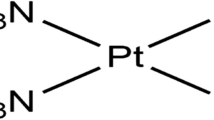Abstract
The present study was done to determine the effect of trolox C, a hydrophilic analogue of vitamin E, on hepatic injury, especially the alteration in cytochrome P-450 (CYP)-dependent drug metabolism during ischemia and reperfusion (l/R). Rats were subjected to 60 min of hepatic ischemia and 5 h of reperfusion. Rats were treated intravenously with trolox C (2.5 mg/kg) or vehicle (PBS, pH 7.4), 5 min before reperfusion. Serum alanine aminotransferase and lipid peroxidation levels were markedly increased after l/R. This increase was significantly suppressed by trolox C. Cytochrome P-450 content was decreased after l/R but was restored by trolox C. There were no significant differences in ethoxyresorufin O-dealkylase (CYP 1A1) and methoxyresorufin O-dealkylase (CYP 1A2) activities among any of the experimental groups. Pentoxyresorufin O-dealkylase (CYP 2B1) activity was decreased and aniline p-hydroxylase (CYP 2E1) activity was increased after l/R. Both these changes were prevented by trolox C. Our findings suggest that trolox C reduces hepatocellular damage as indicated by abnormalities in microsomal drug-metabolizing function during l/R, and that this protection is, in part, caused by decreased lipid peroxidation.
Similar content being viewed by others
References
Barkley, L. R. C., Locke, S. J., and MacNeil, J. M., Autooxidant in micelles: synergism of vitamin C with lipid-soluble vitamin E and water soluble trolox.Can. J. Chem., 63, 366–374 (1985).
Bromant, C., Marie, C., and Bralet, J., Increased lipid peroxidation in vulnerable brain regions after transient forebrain ischemia in rats.Stroke, 20, 918–924 (1989).
Buege, T. A., and Aust S. D., Microsomal lipid peroxidation.Methods Enzymol., 52, 302–310 (1978).
Burke, M. D., Thompson, S., Elcombe, C. R., Halpert, J., Haparanta, T., and Mayer, R. T., Ethoxy-, pentoxy-, and benzyloxyphenoxazones and homologues: a series of substrates to distinguish between different induced cytochromes P-450.Biochem. Biopharmacol., 34, 3337–3345 (1985).
Castle, L., and Perkins, M. J., Inhibition kinetics of chain-breaking phenolic antioxidants in SDS micelles: evidence that intermicellar diffusion rates may be rate-limiting for hydrophobic inhibitors such as alpha-tocopherol.J. Am. Chem. Soc., 108, 6381–6382 (1986).
Doba, T., Burton G. W., and Ingold, K. U., Antioxidant and co-antioxidant activity of vitamin C: the effect of vitamin C, either alone or in the presence of vitamin E or a water-soluble vitamin E analogue, upon the peroxidation of aqueous multilamellar phospholipid liposomes.Biochem. Biophys. Act., 835, 298–303 (1985).
Evans, P. J., Whiteman, M., Tredger, J. M., and Halliwell B., Antioxidant properties of S-adenosyl L-methionine: a proposed addition to organ storage fluids.Free Radic. Biol. Med., 23, 1002–1008 (1997).
Huet, P. M., and Villenueve, J. P., Determinations of drug disposition in patients with cirrhosis.Hepatology, 3, 913–918 (1983).
Ingold, K. U., Webb, A. C., Witter, D., Burton, G. W., Metcalfe, T. A., and Muller D. P., Vitamin E remains the major lipid-soluble, chain-breaking antioxidant in human plasma even in individuals suffering severe vitamin E deficiency.Arch. Biochem. Biophys., 259, 224–225 (1987).
Jaeschke, H., Mechanisms of oxidant stress-induced acute tissue injury.Proc. Soc. Exp. Bio. Med., 209, 104–111 (1995).
Jaeschke, H., and Farhood, A., Neutrophil and Kupffer cell-induced oxidant stress and ischemia-reperfusion injury in rat liver.Am. J. Physiol., 260, G355-G362 (1991).
Jaeschke, H., Farhood, A., and Smith, C. W., Neutrophils contribute to ischemia/reperfusion injury in rat live.in vivo.Am. J. Physiol., 260, G355-G362 (1991).
Lee, S. M., and Cho, T. S., Effect of trolox C on hypoxia/reoxygenation-induced injury in isolated perfused rat liver.Arch. Pharm. Res., 20, 471–475 (1997).
Lee, S. M., and Clemens, M. G., Effect of alpha-tocopherol on hepatic mixed function oxidase in hepatic ischemia/reperfusion.Hepatology, 15, 276–281 (1992).
Lee, S. M., Park, M. J., Cho, T. S., and Clemens, M. G., Hepatic injury and lipid peroxidation during ischemia and reperfusion.Shock, 13, 279–284 (2000).
Marubayasch, S., Dohi, K., Ochi, K., and Kawasaki, T., Role of free radicals in ischemic rat liver cell injury. Prevention of damage by α-tocopherol administration.Surgery, 99, 184–192 (1986).
Mathews, W. R., Guido, D. M., Fisher, M. A., and Jaeschke, H., Lipid peroxidation as molecular mechanism of liver cell injury during reperfusion after ischemia.Free Radic. Biol. Med., 16, 763–770 (1994).
Omar, R., Nomikos, I., Piccorelli, G., Savino, J., and Agarual, N., Prevention of post ischemic lipid peroxidation and liver cell injury by iron chelation.Gut, 30, 510–514 (1989).
Omura, T., and Sato, R., The carbon monoxide binding pigment of liver microsomes.J. Biol. Chem., 239, 2370–2379 (1964).
Petty, M., Grisar, J. M., Dow, J., and Jong, W. D., Effects of an alpha-tocopherol analogue on myocardial ischemia and reperfusion injury in rats.Eur. J. Pharmacol., 179, 241–242 (1990).
Pohl, R. J., and Fouts, J. R., A rapid method for assaying the metabolism of 7-ethoxyresorufin by microsomal subcellular fractions.Anal. Biochem., 107, 150–155 (1980).
Vermillion, J., and Coon, M. J., Purified liver microsomal NADPH-cytochrome P-450 reductase.J. Biol. Chem., 253, 8812–8819 (1978).
Wu, T. W., Hashimoto, N., Wu, J., Cavey, D., Li, R.K., Mickle, D., and Wiesel, R. D., The cytoprotective effect of trolox demonstrated with three types of human cells.Biochem. Cell Biol., 68, 1189–1194 (1990).
Author information
Authors and Affiliations
Corresponding author
Rights and permissions
About this article
Cite this article
Eum, H.A., Lee, S.H. & Lee, S.M. Trolox c ameliorates hepatic drug metabolizing dysfunction after ischemia/reperfusion. Arch Pharm Res 25, 940–945 (2002). https://doi.org/10.1007/BF02977017
Received:
Issue Date:
DOI: https://doi.org/10.1007/BF02977017




